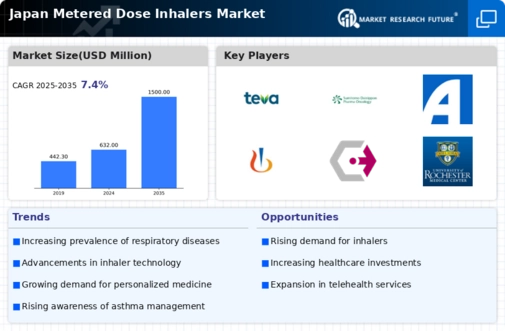Innovations in Inhaler Technology
Technological advancements in inhaler design and functionality are significantly influencing the metered dose-inhalers market. Innovations such as smart inhalers, which provide real-time feedback and tracking for patients, are gaining traction in Japan. These devices enhance medication adherence and allow for better management of respiratory conditions. The integration of digital health technologies into inhalers is expected to attract a younger demographic, who are more inclined to utilize technology for health management. Additionally, improvements in aerosol delivery systems are enhancing the efficiency of drug delivery, making inhalers more effective. The metered dose-inhalers market is likely to benefit from these innovations, as they not only improve patient outcomes but also create new opportunities for manufacturers to differentiate their products in a competitive landscape.
Rising Awareness of Asthma Management
There is a growing awareness of asthma management among the Japanese population, which is positively impacting the metered dose-inhalers market. Educational initiatives by healthcare professionals and organizations are helping patients understand the importance of using inhalers correctly and consistently. This heightened awareness is leading to increased usage of metered dose-inhalers as patients become more proactive in managing their condition. Additionally, the availability of various inhaler options tailored to different patient needs is likely to enhance market growth. The metered dose-inhalers market is expected to benefit from this trend, as more individuals seek effective solutions for asthma management.
Increased Focus on Preventive Healthcare
The shift towards preventive healthcare in Japan is influencing the metered dose-inhalers market. As healthcare systems increasingly emphasize prevention over treatment, there is a growing recognition of the importance of managing respiratory conditions proactively. This trend is leading to higher rates of diagnosis and treatment initiation, which in turn drives demand for metered dose-inhalers. Preventive strategies often involve regular monitoring and the use of inhalers to control symptoms before they escalate. The metered dose-inhalers market is likely to see growth as healthcare providers adopt more proactive approaches to managing respiratory health, thereby increasing the utilization of inhalers among patients.
Rising Prevalence of Respiratory Diseases
The increasing incidence of respiratory diseases in Japan is a primary driver for the metered dose-inhalers market. Conditions such as asthma and chronic obstructive pulmonary disease (COPD) are becoming more prevalent, affecting a significant portion of the population. According to recent health statistics, approximately 10% of the Japanese population suffers from asthma, which necessitates the use of inhalers for effective management. This growing patient base is likely to propel demand for metered dose-inhalers, as they are essential for delivering medication directly to the lungs. Furthermore, the aging population, which is more susceptible to respiratory ailments, is expected to contribute to market growth. The metered dose-inhalers market is thus positioned to expand as healthcare providers increasingly recommend these devices for their efficacy and ease of use.
Government Initiatives and Healthcare Policies
Government initiatives aimed at improving respiratory health are playing a crucial role in shaping the metered dose-inhalers market. The Japanese government has implemented various healthcare policies that promote the use of inhalers for managing chronic respiratory diseases. These policies often include subsidies for patients, making inhalers more accessible and affordable. Furthermore, public health campaigns aimed at raising awareness about respiratory diseases and the importance of proper medication adherence are likely to drive demand for metered dose-inhalers. The metered dose-inhalers market stands to gain from these supportive measures, as they encourage both healthcare providers and patients to prioritize effective treatment options.























Leave a Comment